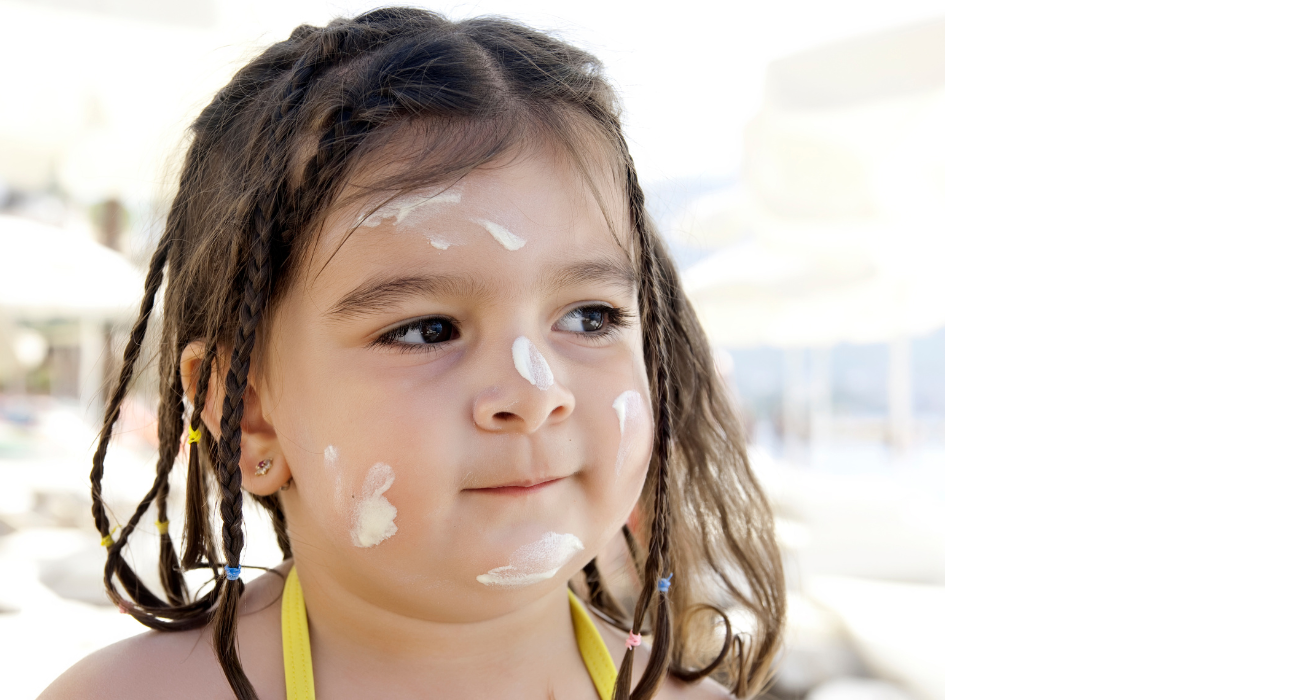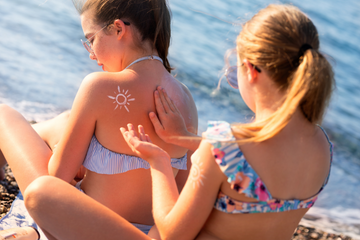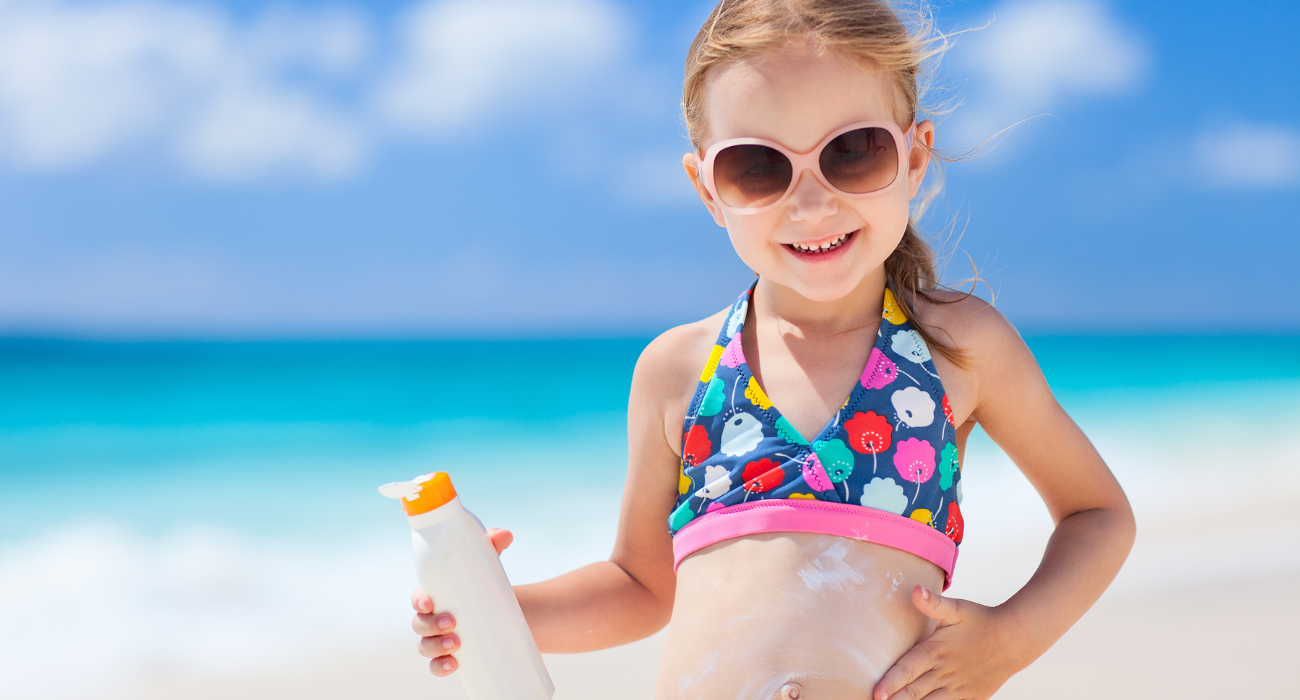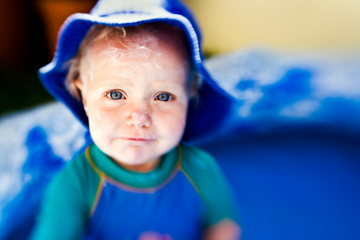SKIN CANCER PREVENTION IN CHILDREN

Why is Sun Protection Important for Kids?
Sun protection is extremely important for children because their skin is more delicate and sensitive than adult skin.
Children's skin has less melanin, the pigment that provides some natural protection against the harmful effects of the sun's ultraviolet (UV) rays. Additionally, children tend to spend more time outdoors than adults and may not always be aware of the potential dangers of sun exposure.
Excessive exposure to the sun's UV rays can cause sunburn, premature aging of the skin, and skin damage that can increase the risk of skin cancer later in life. Children who experience severe sunburns during childhood are more likely to develop skin cancer as adults.
To protect children from the harmful effects of the sun, it is important to use sunscreen with a high sun protection factor (SPF), wear protective clothing such as hats and long-sleeved shirts, and limit sun exposure during peak hours when the sun's rays are strongest. It is also important to teach children good sun safety habits at an early age, so that they can take responsibility for their own sun protection as they grow older.
Wearing protective clothing, applying sunscreen, and seeking shade during peak sun hours can help reduce the risks associated with sun exposure and protect a child's skin.


How to Protect Children from Skin Cancer.
To protect children from skin cancer, it is recommended to follow these steps:
- Encourage them to wear protective clothing like hats and long-sleeved shirts, especially during peak sun hours (10 am to 4 pm).
- Apply a broad-spectrum, water-resistant sunscreen with a Sun Protection Factor (SPF) of at least 30, and reapply it every 2 hours or after swimming or sweating.
- Teach children to seek shade, especially during the hottest part of the day.
- Avoid tanning beds, as they emit harmful UV rays that increase the risk of skin cancer.
- Examine your child's skin regularly and teach them to do the same, looking for any new moles or changes in the appearance of existing moles, which could be signs of skin cancer.
- Encourage a healthy diet rich in fruits and vegetables, as studies have shown that a diet high in antioxidants can help protect against skin cancer.
- Make sure your children receive regular skin exams by a dermatologist as part of their preventive health check ups.

How to Choose Sunscreen for Kids.
Choosing the right sunscreen for your child can be a daunting task, but here are some tips to help you make an informed decision:
- Look for a broad-spectrum sunscreen: Choose a sunscreen that protects against both UVA and UVB rays. UVA rays penetrate deeper into the skin and can cause long-term damage, while UVB rays cause sunburn and immediate damage.
- Choose the appropriate SPF: Look for a sunscreen with an SPF of 30 or higher. Higher SPF does not necessarily provide better protection, but it can provide longer-lasting protection.
- Consider the formulation: Sunscreens come in many different formulations such as creams, lotions, sprays, and sticks. Choose a formulation that your child will be comfortable with and one that will provide adequate coverage.
- Check the ingredients: Look for sunscreens that contain safe and effective ingredients such as zinc oxide or titanium dioxide. Avoid sunscreens that contain oxybenzone or retinyl palmitate.
- Test for skin sensitivity: Before applying sunscreen all over your child's body, test a small amount on their arm or leg to make sure they don't have any adverse reactions.
- Apply sunscreen properly: Apply sunscreen generously to all areas of exposed skin, and reapply every two hours or immediately after swimming or sweating.
- Keep sun safety in mind: Remember that sunscreen is just one tool in protecting your child from the harmful effects of the sun. Encourage your child to wear protective clothing and seek shade when possible, especially during peak sun hours.
Choose a sunscreen specifically formulated for children
Choosing the right sunscreen for children is crucial due to their delicate and sensitive skin.
Children's skin is more vulnerable to the harmful effects of ultraviolet (UV) rays, making adequate sun protection essential. When selecting a sunscreen for children, there are several key factors to consider ensuring that the sunscreen not only effectively protects against UV radiation but also minimises the risk of skin irritation.
Designed for Children's Skin
- Gentle and Hypoallergenic: Children's sunscreen should be formulated to be as gentle as possible, reducing the risk of causing skin irritation or allergic reactions. Hypoallergenic sunscreens are crafted to minimise potential allergens and are ideal for children's sensitive skin.
- Fragrance-Free: Fragrances in skincare products can be a common source of irritation and allergic reactions. Choosing a fragrance-free sunscreen helps lower the risk of any skin discomfort for children.
Physical (Mineral) vs. Chemical Sunscreens
- Physical (Mineral) Sunscreens: These sunscreens use natural minerals such as zinc oxide or titanium dioxide as active ingredients. They sit on top of the skin, reflecting and scattering UV rays away from the skin. Mineral sunscreens are often recommended for children because they are less likely to irritate the skin or cause allergic reactions. They are also effective immediately upon application.
- Chemical Sunscreens: Chemical sunscreens absorb UV rays and convert them into heat, which is then released from the skin. While effective, some chemical filters can cause irritation or allergic reactions in sensitive skin, making them less ideal for children.
Broad-Spectrum Protection
Choose sunscreens that offer broad-spectrum protection, which means they protect against both UVA and UVB rays. UVA rays can prematurely age the skin, while UVB rays are more likely to cause sunburn. Both types of UV radiation contribute to the risk of skin cancer.
Water Resistance
For children who spend a lot of time swimming or playing in the water, water-resistant sunscreen is essential. Water-resistant formulas are designed to maintain their SPF protection for a certain amount of time while the child is in the water, typically for 40 or 80 minutes. Reapplication is necessary after these times to maintain protection.
SPF Recommendation
It is widely recommended to use a sunscreen with an SPF of 50 or higher for adequate protection. While higher SPF values offer more protection, no sunscreen can block 100% of UV rays, making proper application and regular reapplication crucial.
Application Tips
- Generous Application: Apply sunscreen generously 15 to 30 minutes before going outside, ensuring coverage on all exposed skin, including easily forgotten areas like the tops of ears, back of the neck, and feet.
- Regular Reapplication: Reapply sunscreen every two hours, or more frequently if swimming, sweating, or towel-drying.
Test Before Use
Given children's sensitivity, it's advisable to patch test a new sunscreen on a small area of the child's skin before full application. This helps ensure the child does not react adversely to the product.
Selecting a sunscreen specifically formulated for children involves looking for products that are gentle, hypoallergenic, and fragrance-free, with a preference for physical over chemical filters.
Ensuring broad-spectrum, water-resistant protection with an appropriate SPF, along with careful application and reapplication practices, can significantly reduce the risk of sunburn and long-term sun damage for children, promoting healthier skin throughout their lives.
Opt for physical sunscreens
Opting for physical sunscreens, also known as mineral sunscreens, is particularly recommended for children due to their gentler formulation and mode of action on sensitive skin. These sunscreens use zinc oxide or titanium dioxide to create a physical barrier on the skin's surface, reflecting and scattering harmful ultraviolet (UV) rays away from the skin.
This approach to sun protection offers several benefits, especially for the delicate and sensitive skin of children.
Advantages of Physical Sunscreens for Children
- Less Irritating: Physical sunscreens are less likely to cause skin irritation or allergic reactions compared to chemical sunscreens. This makes them ideal for children's skin, which is more sensitive than adult skin.
- Broad-Spectrum Protection: Zinc oxide and titanium dioxide offer broad-spectrum protection, shielding the skin from both UVA and UVB rays. UVA rays penetrate deeply into the skin and are associated with premature aging, while UVB rays are responsible for sunburn. Both contribute to the risk of skin cancer.
- Immediate Effectiveness: Unlike chemical sunscreens, which need to be applied 15 to 30 minutes before sun exposure to be fully effective, physical sunscreens protect the skin as soon as they are applied. This immediate effect is particularly useful for children who may be eager to play outside and less patient during prep time.
- Suitable for Sensitive Skin: Children with skin conditions like eczema or sensitive skin can benefit greatly from physical sunscreens, as they are less likely to exacerbate these conditions.
- Environmentally Friendly: Recent studies suggest that some chemical sunscreen ingredients can harm marine life and coral reefs. Physical sunscreens are considered to be more environmentally friendly, making them a preferable choice for eco-conscious parents.
Considerations When Choosing Physical Sunscreens for Children
- Visible Residue: Physical sunscreens can sometimes leave a white cast on the skin after application. While newer formulations are designed to minimise this effect, it's something to consider, especially for children with darker skin tones.
- Application: Because they form a physical barrier, physical sunscreens may need to be applied more thickly to ensure complete coverage. They can also be rubbed off more easily by clothing, towels, or sand, necessitating frequent reapplication, especially after swimming or sweating.
- Water Resistance: While there are water-resistant options available, not all physical sunscreens are water-resistant. It's important to check the label if the child will be engaging in water activities or sweating.
Tips for Using Physical Sunscreens on Children
- Generous Application: Apply the sunscreen generously on all exposed areas of the skin, including often-missed spots like the tops of the ears, back of the neck, and the tops of the feet.
- Reapplication: Reapply sunscreen every two hours, or more often if the child is swimming, sweating, or towel-drying.
- Patch Test: Before using any new sunscreen product on a child, consider doing a patch test on a small area of their skin to ensure there is no allergic reaction or irritation.
Opting for physical sunscreens for children can provide effective, gentle protection against the harmful effects of UV radiation. By choosing products containing zinc oxide or titanium dioxide, parents can ensure their children are shielded in a way that's both safe for their skin and the environment.
Check for irritants
When selecting sunscreens for children, it's essential to scrutinise the ingredient list for potential irritants that could harm their sensitive skin. Children's skin is thinner and more permeable than adult skin, making it more susceptible to irritation and allergic reactions from harsh chemicals. To ensure the sunscreen provides protection without causing discomfort or adverse reactions, look for products free from common irritants such as alcohol, fragrances, preservatives, and parabens.
Common Irritants in Sunscreens
- Alcohol: Often used in sunscreen formulations for its quick-drying properties, alcohol can be drying and irritating, especially on sensitive or eczema-prone skin. It can strip away the skin's natural oils, leading to dryness and irritation.
- Fragrances: Synthetic fragrances are among the most common causes of allergic reactions in skincare products. They can cause irritation, redness, and rashes, particularly in children with sensitive skin. Opting for fragrance-free sunscreens minimizes the risk of such reactions.
- Preservatives: While necessary to prevent the growth of bacteria and fungi in sunscreens, certain preservatives like methylisothiazolinone (MI) and parabens have been linked to skin allergies and irritation. Preservative-free or sunscreens with less irritating preservatives are preferable for children's skin.
- Parabens: Used as preservatives in many cosmetic and skincare products, parabens can mimic estrogen and have been a topic of concern regarding potential health effects. Although the research is ongoing, many parents prefer to err on the side of caution and choose paraben-free products for their children.
Tips for Choosing a Child-Friendly Sunscreen
- Read Labels Carefully: Look for sunscreens labeled as "for sensitive skin," "fragrance-free," "alcohol-free," and "paraben-free" to avoid common irritants.
- Look for Mineral Sunscreens: Zinc oxide and titanium dioxide are generally well-tolerated by sensitive skin and are less likely to cause irritation. These ingredients are also less likely to penetrate the skin, minimising the risk of adverse reactions.
- Test Before Use: Before applying any new sunscreen on a child's entire body, test it on a small skin area. Wait for 24 hours to ensure there is no redness, swelling, or irritation.
- Consult with a Dermatologist: If your child has known skin sensitivities, allergies, or conditions like eczema, it may be beneficial to consult with a dermatologist for personalised sunscreen recommendations.
- Opt for Creams over Sprays: Cream sunscreens tend to have fewer irritants compared to spray sunscreens, which often contain alcohol to ensure the product dries quickly on the skin. Creams also provide a more even and controllable application.
Choosing the right sunscreen for children involves more than just looking at the SPF rating; it requires careful consideration of the product's ingredients to avoid potential irritants.
By selecting sunscreens formulated without alcohol, fragrances, preservatives, or parabens, parents can provide their children with the sun protection they need while minimising the risk of skin irritation.
Look for broad-spectrum protection
When selecting sunscreen for children, it's crucial to ensure the product offers broad-spectrum protection.
This means it has been formulated to protect the skin from both UVA and UVB rays, the two types of ultraviolet radiation that reach the earth's surface and can harm the skin. Understanding the difference between these rays and the importance of broad-spectrum protection is key to safeguarding children's delicate skin against sun damage.
Understanding UVA and UVB Rays
- UVA Rays: UVA rays account for the majority of UV radiation that reaches the earth's surface. They can penetrate clouds and glass, reaching the skin even on cloudy days or while indoors near windows. UVA rays penetrate the skin more deeply than UVB rays and are primarily responsible for premature aging, including wrinkles and sunspots. They also play a significant role in the development of skin cancers.
- UVB Rays: UVB rays are the main cause of sunburn and play a critical role in the development of skin cancer. The intensity of UVB rays varies by location, season, and time of day, with the highest risk occurring during midday hours, summer months, and closer to the equator.
The Importance of Broad-Spectrum Protection
- Comprehensive Sun Defense: Broad-spectrum sunscreens are designed to absorb, reflect, or scatter both UVA and UVB rays, offering comprehensive protection against sunburn, premature aging, and skin cancer risk. This is particularly important for children, whose skin is more vulnerable to the damaging effects of UV radiation.
- Preventing Skin Cancer: Regular use of broad-spectrum sunscreen from an early age can significantly reduce the lifetime risk of developing skin cancers, including melanoma, the most dangerous form of skin cancer.
- Maintaining Healthy Skin: Protecting children's skin from UVA and UVB rays helps preserve skin health, preventing the early onset of signs of aging and maintaining skin resilience.
Choosing the Right Broad-Spectrum Sunscreen for Children
- Look for the Label: Always check the sunscreen label to ensure it states "broad-spectrum." This indicates the sunscreen has been tested and approved to protect against both UVA and UVB rays.
- SPF Factor: Choose a sunscreen with an SPF (Sun Protection Factor) of 50 or higher for adequate protection against UVB rays. The SPF rating indicates how long the sunscreen will protect the skin from reddening or burning from UVB rays compared to no sunscreen.
- Water Resistance: For children who spend time swimming or sweating, opt for a water-resistant broad-spectrum sunscreen. Remember that water-resistant does not mean waterproof, so reapplication is necessary after swimming, sweating, or toweling off.
- Sensitive Skin Formulations: Since children's skin can be especially sensitive, look for broad-spectrum sunscreens that are also formulated for sensitive skin. These products are often free from potential irritants like fragrances, parabens, and alcohols.
Choosing a broad-spectrum sunscreen for children is a critical step in ensuring their skin is protected from the harmful effects of both UVA and UVB rays. By selecting a product that offers comprehensive protection, parents can help safeguard their children's skin against sunburn, premature aging, and the increased risk of skin cancer, promoting healthier skin throughout their lives.
Check the SPF
Selecting a sunscreen with an SPF (Sun Protection Factor) of 50 or higher for children is a crucial aspect of effective sun protection strategy. The SPF rating quantifies the level of protection a sunscreen offers against UVB rays, the primary cause of sunburn and a significant risk factor for skin cancer.
Here's why an SPF of 50 or higher is recommended and what it means for protecting children's sensitive skin.
Understanding SPF and Its Importance
- SPF Meaning: The SPF number indicates how much longer a person can be exposed to the sun without getting sunburned, compared to unprotected skin. For example, if a child’s skin would normally start turning red after 10 minutes in the sun, applying an SPF 30 sunscreen theoretically prevents sunburn for 300 minutes (10 minutes x 30). However, this is under ideal conditions, and factors like sweating, swimming, and towel drying can reduce effectiveness.
- Broad-Spectrum Protection: While SPF primarily measures protection against UVB rays, it's important to choose a sunscreen that also offers broad-spectrum coverage, protecting against UVA rays. UVA rays penetrate the skin more deeply and are associated with aging and long-term skin damage.
Why SPF 30 or Higher?
- Enhanced Protection: SPF 30 blocks approximately 97% of UVB rays, providing a high level of protection from sunburn and skin damage. Higher SPFs offer slightly more protection; for instance, SPF 50 blocks about 98% of UVB rays. However, no sunscreen can block 100% of UV rays, which is why additional sun protection measures are essential.
- Margin of Error in Application: People often apply less sunscreen than recommended, reducing the actual protection received. A higher SPF gives a buffer that can help compensate for thinner application, although it's still crucial to apply sunscreen generously and reapply every two hours or after swimming or sweating.
Considerations for Choosing Sunscreen for Children
- Formulation for Sensitive Skin: Children's skin is more sensitive than adult skin. Look for sunscreens labeled as suitable for sensitive skin, free from potential irritants like fragrances, parabens, and alcohols. Mineral (physical) sunscreens containing zinc oxide or titanium dioxide are often recommended for children because they are less likely to cause skin irritation.
- Water Resistance: For kids who swim or sweat a lot, water-resistant sunscreen is a must. Remember that "water-resistant" does not mean "waterproof," and reapplication is necessary after swimming, sweating, or towel drying.
- Ease of Application: Creams are often recommended for their ease of application on the face and coverage control. However, sprays can be convenient for quick application on the body, though they should be applied carefully to ensure even coverage and avoid inhalation.
Application Tips
- Generous Application: Most people do not apply enough sunscreen. A good rule of thumb is to use about 30 grams (enough to fill a shot glass) to cover the exposed areas of the body.
- Reapplication: Sunscreen should be reapplied every two hours, or more often if swimming or sweating. This is crucial for maintaining effective sun protection throughout the day.
Choosing a sunscreen with an SPF of 30 or higher for children is vital for providing effective protection against UVB rays and minimising the risk of sunburn and skin damage. Along with selecting the appropriate SPF, ensuring the sunscreen is broad-spectrum, suitable for sensitive skin, and correctly applied will maximise protection for children's delicate skin during sun exposure.
Do a Patch Test
Conducting a patch test before applying a new sunscreen to a child’s entire body is an essential step in identifying potential allergic reactions or sensitivities to the product. Children’s skin is more delicate and reactive than adult skin, making it more susceptible to irritants and allergens.
A patch test helps to minimise the risk of widespread skin irritation or an allergic reaction by testing the product on a small, controlled area first.
How to Conduct a Patch Test
- Select a Small Area: Choose a small, discreet area of skin to apply the sunscreen. The inner forearm or the back of the neck are commonly recommended spots because they tend to be sensitive and representative of how the rest of the skin might react.
- Apply a Small Amount: Apply a small amount of the sunscreen to the selected area. It doesn’t need to be a thick layer, but it should cover the area well enough to accurately test for a reaction.
- Wait and Observe: Wait at least 24 hours, and ideally up to 48 hours, to see if there is any reaction. During this time, monitor the area for signs of irritation, redness, swelling, or any other adverse effects.
- Evaluate the Results: If no reaction occurs, it’s generally safe to assume that the sunscreen is safe for use on the rest of the child’s body. If there is a reaction, wash the area with soap and water and discontinue use of the product. You may need to try a different sunscreen that has a different set of ingredients.
Why Patch Testing is Important
- Prevents Allergic Reactions: Some sunscreen ingredients, even those formulated for sensitive skin, can cause allergic reactions in certain individuals. A patch test helps identify these reactions before the product is applied more broadly.
- Identifies Irritants: Beyond allergic reactions, some ingredients might irritate a child’s skin. Irritants can cause discomfort, redness, and other mild to severe skin issues.
- Safety and Comfort: Ensuring the sunscreen doesn’t cause adverse reactions in your child is essential for their comfort and safety. It also ensures that the sunscreen can be used effectively to protect against UV rays without causing additional problems.
Considerations
- Repeat with New Products: Conduct a patch test every time you try a new sunscreen on your child, even if they’ve previously used other sunscreens without issue. Different formulations can contain varying ingredients that may not be suitable for your child’s skin.
- Consult a Healthcare Provider: If your child has a history of skin allergies or sensitive skin, consult a healthcare provider for recommendations on suitable sunscreen options or to discuss the best way to conduct a patch test.
- Check Ingredients: If a reaction occurs, take note of the ingredients in the sunscreen. This can help you identify potential allergens or irritants to avoid in future products.
A patch test is a simple and effective precautionary measure to ensure the sunscreen you choose for your child is safe and won’t cause skin irritation or allergic reactions.
This step is crucial in safeguarding your child’s skin health while protecting them from the harmful effects of UV radiation.
Reapply Frequently
Reapplying sunscreen frequently is a critical component of effective sun protection, especially for children.
Their skin is more susceptible to UV damage, making consistent sunscreen application essential for preventing sunburn and reducing the risk of long-term skin damage.
Here’s why frequent reapplication is necessary and how to implement it effectively.
The Need for Frequent Reapplication
- Sunscreen Breakdown: Sunscreen ingredients can break down when exposed to sunlight over time, losing their effectiveness in protecting the skin against UV radiation. This degradation necessitates reapplication to maintain a protective barrier.
- Physical Removal: Activities such as swimming, sweating, and towel drying can physically remove sunscreen from the skin, even if the product is labeled as water-resistant. This removal significantly reduces the level of protection offered, making reapplication crucial after these activities.
- Ensuring Uniform Coverage: Initial applications of sunscreen may miss certain areas or may not be applied thickly enough. Reapplying helps cover any missed spots and ensures a uniform layer of protection across all exposed areas of the skin.
Guidelines for Reapplication
- Every Two Hours: As a general rule, sunscreen should be reapplied every two hours when spending time outdoors. This timing should be adjusted based on activities and conditions that may accelerate the need for reapplication.
- After Swimming or Sweating: Water-resistant sunscreens are specifically formulated to withstand water exposure for either 40 or 80 minutes, as indicated on the product label. However, it’s best to reapply sunscreen immediately after coming out of the water or after sweating profusely, regardless of the time spent in the water.
- Following Towel Drying: Towel drying can remove sunscreen from the skin. Even if the two-hour mark or water exposure guidelines have not been reached, reapply sunscreen after drying off with a towel.
Tips for Effective Reapplication
- Use Enough Sunscreen: For full-body coverage, most adults need about 30 grams (roughly the size of a shot glass) of sunscreen. For children, this amount may be less, but a generous application is still necessary. Ensure you're applying enough product to maintain the SPF's protective benefits.
- Don't Forget Hard-to-Reach and Sensitive Areas: Pay special attention to areas like the ears, back of the neck, tops of feet, and along the hairline. These areas are often overlooked during both initial application and reapplication.
- Incorporate Sun-Protective Clothing: In addition to sunscreen, dressing children in sun-protective clothing, including wide-brimmed hats and sunglasses, can provide an additional layer of UV protection. Clothing can be particularly useful for covering areas that may not receive as much sunscreen as needed.
- Make Reapplication Routine: Set a timer or use activities as reminders to reapply sunscreen. Making reapplication part of the routine, such as after a snack break or at specific intervals, can help ensure it's not forgotten.
Frequent reapplication of sunscreen is a non-negotiable part of sun safety for children.
It compensates for the loss of protection due to physical removal and the breakdown of active ingredients. By adhering to the guidelines for reapplication and using sun protection measures, parents and caregivers can significantly reduce the risk of sunburn and UV damage, promoting healthier skin for their children.
| Powered by Kaptol Media


